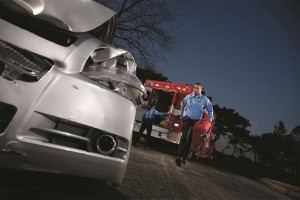You may be paying more for food and housing, but that trip to work is likely costing you less these days. In fact, driving costs have fallen to their lowest level in six years, according to an annual study by AAA.
The travel and road service firm estimates the average driver will spend $8,858 to own and operate the typical vehicle this year, a figure that works out to around 57 cents per mile. Credit goes to one particular factor, said AAA managing director John Nielsen.
“Thanks to lower gas prices, American drivers can expect to save hundreds of dollars in fuel costs in 2016,” said Nielsen. “Fortunately, this annual savings more than offsets the moderate increases in maintenance, insurance, finance charges and other costs associated with owning and operating a vehicle.”
In fact, fuel prices were the only category in which costs were forecast to decline this year, according to AAA. But the decline is significant. Even with recent bumps upward, the forecast in the 2016 Your Driving Costs study is for a $414, or 24.62%, year-over-year decline, to around 8.45 cents per mile, or $1,267.50 for the full year.
(Fuel prices rise as refiners switch to summer blends. Click Here for more.)
The category with the biggest increase is insurance, costs rising by $107, or 9.6%, to an average of $1,222. Ironically, one reason why premiums are going up, according to a AAA analysis, is “lower gas prices, which have resulted in more miles driven, greater numbers of collisions and higher insurance payouts.”
(17-year-old is latest to die due to defective Takata airbags. Click Here for the story.)
Maintenance costs are expected to rise 3.33%, to 5.28 cents per mile, or $792 annually. Put the blame on a variety of factors, including the fact that the latest cars generally require more expensive synthetic oils. Also, many owners are now getting the bill for having delayed routine repairs and maintenance during the economic downturn. It also doesn’t help that at an average of more than 11 years, the average vehicle on the road today is older than ever.
Other costs going up include:
- Licenses, registration and taxes are going up 3.31%, to $687 a year. That reflects both the higher rising cost of new vehicles and increased fees charged by cash-strapped governments;
- Depreciation us up 2.87%, or $105, to $3,759 a year. This is, in fact, the largest ownership expense, notes AAA, and is going up because, with more used and off-lease vehicles entering the market, resale prices are going down;
- Finance Charges are up 2.09%, or $14, to $683 a year. Despite the recent rise in interest rates by the Federal Reserve, however, automotive financing has remained “relatively unchanged,” says AAA;
- Tires are up by 2.04%, to $150 a year. But in terms of the actual impact on your wallet, this is negligible. The increase works out to just 0.02 cents a mile, or $3 a year.
Of course, all these numbers will vary widely and depend upon a variety of factors, including where you live, your average commute, your driving record, how you drive and what you drive.
A large sedan is the most expensive vehicle for the typical driver to own and operate, AAA suggesting that for a motorist clocking 15,000 miles a year that vehicle will run $0.6994 a mile, or $10,492 annually. At the other end of the spectrum, a small sedan comes in at $0.4386 a mile, or $6,579 annually.
Ever more popular SUVs will average $0.6837 a mile, according to the Driving Costs study, or $10,255 a year.
(Americans driving farther, and dying faster, on US highways. Click Here for more.)


